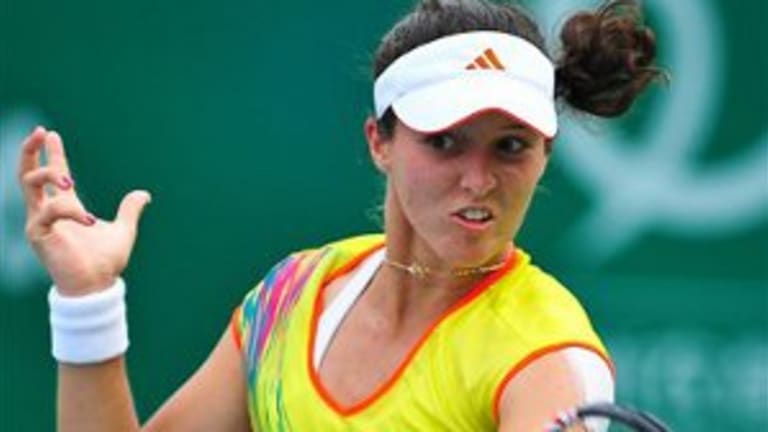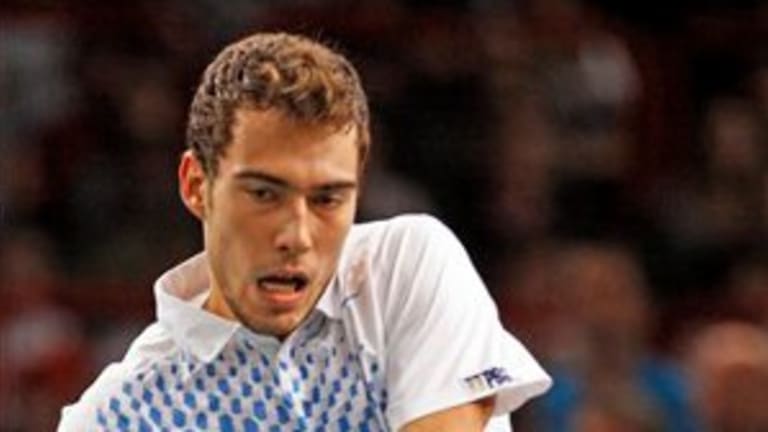Peter Bodo continues his year-end awards—12 in all, for 2012—with the Newcomers of the Year. You can see rest of his selections as well as the upcoming awards at the end of this article.
12 for '12: Newcomers of the Year
By Peter Bodo Dec 04, 2012WTA Brisbane, Australia
Aryna Sabalenka and Paula Badosa team up for Brisbane doubles
By Stephanie Livaudais Jan 03, 2026United Cup
United Cup, Day 2 Preview: Taylor Fritz and Coco Gauff run it back for the U.S.
By Steve Tignor Jan 02, 2026United Cup
Naomi Osaka carries off-season illness into United Cup debut
By David Kane Jan 02, 2026United Cup
Sebastian Baez, Solana Sierra score first wins of 2026 tennis season at United Cup
By John Berkok Jan 02, 2026Australian Open
Venus Williams will become oldest woman to compete in an Australian Open main draw with wild card entry
By Associated Press Jan 02, 2026United Cup
Stefanos Tstisipas pondered future of career while sidelined, says father is “much better communicator” now
By TENNIS.com Jan 01, 2026United Cup
United Cup, Day 1 Preview: Naomi Osaka begins promising 2026, Stefanos Tsitsipas back from injury
By Steve Tignor Jan 01, 2026Setting the Table for 2026
What to expect from Carlos and Jannik in 2026 as year three of the Sincaraz Era begins
By Steve Tignor Jan 01, 2026Summer Down Under
Tennis set for two weeks of mania ahead of 2026 Australian Open
By Associated Press Jan 01, 2026Advertising

12 for '12: Newcomers of the Year
Women’s: Laura Robson
We’ve been reading and hearing about Robson for so long that if you didn’t know better, you might think she’s in her mid-20s. That’s the price paid by the unique double whammy this 18-year-old represents.
Robson was a brilliant prodigy; she won the junior title at Wimbledon at age 14. And she’s British—a fact that explains why so much attention (much of it neither warranted by results nor especially helpful) has been heaped upon her by a domestic press corps thirsting for players capable of winning, or even getting to the third or fourth round, at the most prestigious Grand Slam of them all.
Robson seems to have handled the pressure and demands of those expectations remarkably well, and seems a lively, gregarious, well-balanced young lady. That speaks well for her future, but it also raises a question that will be particularly relevant in the coming two or three years. Having attained celebrity status in the UK, particularly in the media and commercial center of London, will she still feel motivated to maximize her talent and join Andy Murray as a Grand Slam champion?
A tall and rangy left-hander (5’11”, 150 lbs.), Robson’s game is based on a powerful serve, clean technique, and excellent match temperament. Her outstanding weakness is athleticism, or a lack thereof. She isn’t the best mover in the game, but when she’s dialed in with her powerful groundstrokes, she doesn’t need to be. And in 2012, Robson demonstrated that she has a good grasp of strategy and tactics.
Robson qualified for the Australian Open (where she lost to Jelena Jankovic in the first round), but failed to win another match until March, when she notched one at in the Clearwater ITF event. By then, her ranking was No. 120, and it remained in that vicinity through the French Open.
Robson’s run started on the grass at Eastbourne; she won five matches there (three in qualifying) and made it into the Top 100. At Wimbledon, she had plenty of chances to upset former French Open champ Francesca Schiavone, but lost her first-rounder, 6-4 in the third. She then had a good win over No. 23 Lucie Safarova on the same grass courts at the London Olympics. While she lost in the second round to Maria Sharapova, she partnered with Murray to become a silver medalist in mixed doubles.
The game changer for Robson’s year probably was the U.S. Open, where she delivered back-to-back upsets over unseeded but always dangerous Kim Clijsters, and ninth-seeded Li Na. She played a solid match against defending champ Sam Stosur in the fourth round, but lost in straights.
Robson picked up a lot of confidence from that showing; at her next event, in Guangzhou, she became the first British female finalist in a WTA tournament sunce Jo Durie in 1990. Robson lost that hard-fought final to Hsieh Su-Wei, 6-4 in the third, but she continued to play well, qualifying for Beijing and Osaka to close out her memorable year.
Honorable Mention: Sloane Stephens
As the choice of Robson shows, it’s very hard to call anyone on the pro tour a “newcomer.” My baseline criteria for qualification is that the player is young and comes from outside the Top 100 at the start of the year. Stephens was No. 97 at the start of the year, and she didn’t have a performance comparable to Robson’s U.S. Open. But let’s acknowledge her anyway; she made great strides this year, finishing at No. 38, and is on the short list for Most Improved Player.
Advertising

12 for '12: Newcomers of the Year
Men’s: Jerzy Janowicz
Is Janowicz the next John Isner or Milos Raonic, or will he make even better use of his size (6’8”, 200 lbs.) and power to bring to full expression the concept of “Big Man Tennis?”
That tagline came to us courtesy of Saddlebrook’s Craig Boynton, who until recently was Isner’s coach. His former student’s brand of BMT is based on using his serve, reach, and outstanding forehand to play first-strike tennis, predicated on the idea that the longer a point goes on, the more Isner’s chances decline.
It’s a serviceable idea, but Janowicz may be versatile enough to eliminate the minimalist nature of BMT, and thereby pose an even greater threat to the men who rule the game. The 22-year-old moves very well for a man of his size, and has surprisingly deft touch, as he demonstrated at the Paris Masters. With his artful use of the drop shot and volley, Janowicz delievered his best performance of 2012, a runner-up finish (to David Ferrer) in the last event on the ATP tour this year. It improved Janowicz’s ranking to No. 26; he started the season at No. 221.
Janowicz missed the Australian Open (he would have had to qualify) because he couldn’t afford the trip. He’s also spent some time on the Futures and Challenger circuits sleeping in his car (given his size, I’m assuming he was traveling in a 1962 Pontiac Bonneville). But in Bercy he did almost no sleeping at all. He was so jacked up after qualifying and knocking off four Top 20 players that he didn’t sleep at all, joking before he played Ferrer: “I could sleep (last night), no problem. I slept very well two hours, so no problem to sleep whatsoever. . .”
The first sign of what was in store came in early May at the Rome-2 Challenger, where Janowicz, then ranked No. 189, won the title behind noteworthy wins over Ernests Gulbis and Gilles Muller. He then lost in the third round of qualifying at Roland Garros, but had a good win over Steve Darcis at the Prostejov Challenger.
Granted, being from Poland ensured that Janowicz was no stranger to clay, but those still were outstanding results on dirt for a man with the classic big game. A few weeks later, Janowicz found himself on a surface more suited to his weapons; he qualified for Wimbledon and had wins over Simone Bolelli and Gulbis (again) before losing, 7-5 in the fifth, to Florian Mayer. By the end of the tournament, Janowicz’s ranking was up to No. 109, and he celebrated by winning his next event, the Scheveningin Challenger. The win bumped him into the Top 100.
Janowicz experienced some turbulence over the next few weeks, probably in response to the pressure he felt as a newly-minted direct acceptance player. The low point of his outstanding year probably was a first-round U.S. Open loss to the USA’s Dennis Novikov—a wild card ranked outside the Top 1,000 at the time (that’s no typo, either).
Janowicz held his ground in the ensuing weeks until his big breakout in Paris. Forced to qualify for the elite Masters event because of his ranking (then No. 69), he went to town on a string of experienced players, starting with Dmitry Tursunov. He then toppled Marin Cilic, Janko Tipsarevic, and world No. 3 Andy Murray. In the semis, he edged France’s own Gilles Simon.
“The semi-final is something unbelievable for me and for my family. My family was crying after yesterday's match and after today's match,” said Janowicz. “So this is an unbelievable week for my whole family. Maybe because of this win, I will get some bigger sponsors because I was struggling at the beginning of this year and last year a little bit with money.”
Janowicz earned over a quarter of a million U.S. dollars for making the final in Paris, which should relieve his financial anxieties for a while. A rich version of Big Man Tennis might lift him above those concerns for good in 2013.
Honorable Mention: David Goffin
It says a lot about tennis that Janowicz’s main competition for “newcomer” honors was a 5’11’, 150-pounder whose crafty game, while lacking power, was good enough to craft one of the more memorable Grand Slam stories of the year. Goffin qualified for Roland Garros, and nobody was able to stop the 21-year-old until he met Roger Federer in fourth round. Goffin, who started the season ranked No. 174, rocketed up to No. 46.
12 for '12: Year-End Awards
**- Wednesday, November 28: Coaches of the Year
- Thursday, November 29: Doubles Performances of the Year
- Friday, November 30: Tournaments of the Year
- Saturday, December 1: Upsets of the Year
- Sunday, December 2: Quotes of the Year
- Monday, December 3: Feuds of the Year
- Tuesday, December 4: Newcomers of the Year
- Wednesday, December 5: Most Improved Players
- Thursday, December 6: Biggest Disappointments
- Friday, December 7: Comebacks of the Year
- Saturday, December 8: Runner-Ups of the Year
- Sunday, December 9: Stories of the Year**
**Player of the Year, Men: Novak Djokovic
Player of the Year, Women: Serena Williams**